西安电子科技大学:《博弈论》课程教学资源(PPT课件)Lecture 4 Static game of incomplete information
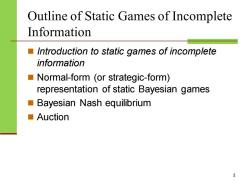
Outline of Static Games of Incomplete Information Introduction to static games of incomplete information Normal-form (or strategic-form) representation of static Bayesian games Bayesian Nash equilibrium ■Auction
Outline of Static Games of Incomplete Information ◼ Introduction to static games of incomplete information ◼ Normal-form (or strategic-form) representation of static Bayesian games ◼ Bayesian Nash equilibrium ◼ Auction 2
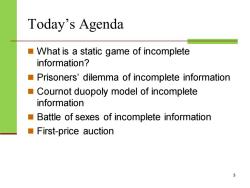
Today's Agenda What is a static game of incomplete information? Prisoners'dilemma of incomplete information Cournot duopoly model of incomplete information Battle of sexes of incomplete information First-price auction 3
Today’s Agenda ◼ What is a static game of incomplete information? ◼ Prisoners’ dilemma of incomplete information ◼ Cournot duopoly model of incomplete information ◼ Battle of sexes of incomplete information ◼ First-price auction 3
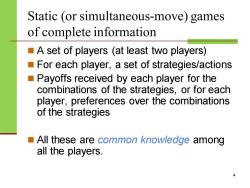
Static (or simultaneous-move)games of complete information A set of players (at least two players) For each player,a set of strategies/actions Payoffs received by each player for the combinations of the strategies,or for each player,preferences over the combinations of the strategies All these are common knowledge among all the players
Static (or simultaneous-move) games of complete information ◼ A set of players (at least two players) ◼ For each player, a set of strategies/actions ◼ Payoffs received by each player for the combinations of the strategies, or for each player, preferences over the combinations of the strategies ◼ All these are common knowledge among all the players. 4
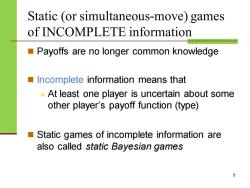
Static (or simultaneous-move)games of INCOMPLETE information Payoffs are no longer common knowledge Incomplete information means that >At least one player is uncertain about some other player's payoff function (type) Static games of incomplete information are also called static Bayesian games
Static (or simultaneous-move) games of INCOMPLETE information ◼ Payoffs are no longer common knowledge ◼ Incomplete information means that ➢ At least one player is uncertain about some other player’s payoff function (type) ◼ Static games of incomplete information are also called static Bayesian games 5

Prisoners'dilemma of complete information Two suspects held in separate cells are charged with a major crime. However,there is not enough evidence. ■ Both suspects are told the following policy: >If neither confesses then both will be convicted of a minor offense and sentenced to one month in jail. >If both confess then both will be sentenced to jail for six months. If one confesses but the other does not,then the confessor will be released but the other will be sentenced to jail for nine months. Prisoner 2 Mum Confess Mum -1 -1 -9 Q Prisoner 1 Confess 0 -9 -6,-6 6
Prisoners’ dilemma of complete information Prisoner 2 Mum Confess Prisoner 1 Mum -1 , -1 -9 , 0 Confess 0 , -9 -6 , -6 6 ◼ Two suspects held in separate cells are charged with a major crime. However, there is not enough evidence. ◼ Both suspects are told the following policy: ➢ If neither confesses then both will be convicted of a minor offense and sentenced to one month in jail. ➢ If both confess then both will be sentenced to jail for six months. ➢ If one confesses but the other does not, then the confessor will be released but the other will be sentenced to jail for nine months
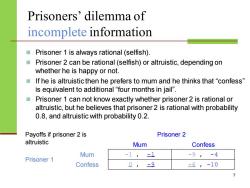
Prisoners'dilemma of incomplete information ■ Prisoner 1 is always rational(selfish). ■ Prisoner 2 can be rational(selfish)or altruistic,depending on whether he is happy or not. ■If he is altruistic then he prefers to mum and he thinks that“confess” is equivalent to additional "four months in jail". Prisoner 1 can not know exactly whether prisoner 2 is rational or altruistic,but he believes that prisoner 2 is rational with probability 0.8,and altruistic with probability 0.2. Payoffs if prisoner 2 is Prisoner 2 altruistic Mum Confess Mum -1, -1 -91 -4 Prisoner 1 Confess -9 -6,-10 7
Prisoners’ dilemma of incomplete information Payoffs if prisoner 2 is altruistic Prisoner 2 Mum Confess Prisoner 1 Mum -1 , -1 -9 , -4 Confess 0 , -9 -6 , -10 7 ◼ Prisoner 1 is always rational (selfish). ◼ Prisoner 2 can be rational (selfish) or altruistic, depending on whether he is happy or not. ◼ If he is altruistic then he prefers to mum and he thinks that “confess” is equivalent to additional “four months in jail”. ◼ Prisoner 1 can not know exactly whether prisoner 2 is rational or altruistic, but he believes that prisoner 2 is rational with probability 0.8, and altruistic with probability 0.2
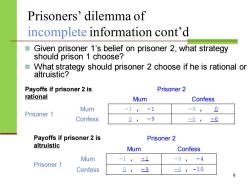
Prisoners'dilemma of incomplete information cont'd ■ Given prisoner 1's belief on prisoner 2,what strategy should prison 1 choose? ■ What strategy should prisoner 2 choose if he is rational or altruistic? Payoffs if prisoner 2 is Prisoner 2 rational Mum Confess Mum -1 -1 -9, 0 Prisoner 1 Confess 0 -9 -6,-6 Payoffs if prisoner 2 is Prisoner 2 altruistic Mum Confess Mum -1, -1 -9 -4 Prisoner 1 Confess 0 -9 =6,-10
Prisoners’ dilemma of incomplete information cont’d Payoffs if prisoner 2 is rational Prisoner 2 Mum Confess Prisoner 1 Mum -1 , -1 -9 , 0 Confess 0 , -9 -6 , -6 8 ◼ Given prisoner 1’s belief on prisoner 2, what strategy should prison 1 choose? ◼ What strategy should prisoner 2 choose if he is rational or altruistic? Payoffs if prisoner 2 is altruistic Prisoner 2 Mum Confess Prisoner 1 Mum -1 , -1 -9 , -4 Confess 0 , -9 -6 , -10
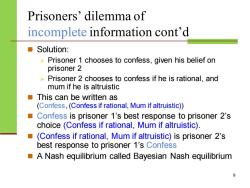
Prisoners'dilemma of incomplete information cont'd ■Solution: -Prisoner 1 chooses to confess,given his belief on prisoner 2 Prisoner 2 chooses to confess if he is rational,and mum if he is altruistic ■This can be written as (Confess,(Confess if rational,Mum if altruistic)) Confess is prisoner 1's best response to prisoner 2's choice(Confess if rational,Mum if altruistic). (Confess if rational,Mum if altruistic)is prisoner 2's best response to prisoner 1's Confess A Nash equilibrium called Bayesian Nash equilibrium
Prisoners’ dilemma of incomplete information cont’d ◼ Solution: ➢ Prisoner 1 chooses to confess, given his belief on prisoner 2 ➢ Prisoner 2 chooses to confess if he is rational, and mum if he is altruistic ◼ This can be written as (Confess, (Confess if rational, Mum if altruistic)) ◼ Confess is prisoner 1’s best response to prisoner 2’s choice (Confess if rational, Mum if altruistic). ◼ (Confess if rational, Mum if altruistic) is prisoner 2’s best response to prisoner 1’s Confess ◼ A Nash equilibrium called Bayesian Nash equilibrium 9
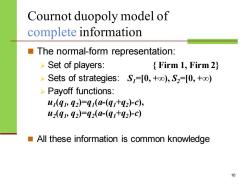
Cournot duopoly model of complete information The normal-form representation: -Set of players: Firm 1,Firm 2) Sets of strategies:S=[0,+oo),S2=10,+o0) >Payoff functions: u(qw92)=q(a-(91+92-C), u2(9wq2)=q2(-(q1+42c) All these information is common knowledge 10
Cournot duopoly model of complete information ◼ The normal-form representation: ➢ Set of players: { Firm 1, Firm 2} ➢ Sets of strategies: S1 =[0, +∞), S2 =[0, +∞) ➢ Payoff functions: u1 (q1 , q2 )=q1 (a-(q1+q2 )-c), u2 (q1 , q2 )=q2 (a-(q1+q2 )-c) ◼ All these information is common knowledge 10
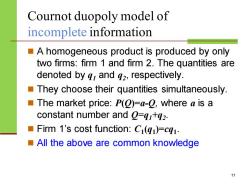
Cournot duopoly model of incomplete information A homogeneous product is produced by only two firms:firm 1 and firm 2.The quantities are denoted by q,and 42,respectively. They choose their quantities simultaneously. The market price:P(O)=a-2,where a is a constant number and Q=q1+q2. Firm 1's cost function:Ci(q1)=cq1. All the above are common knowledge 11
Cournot duopoly model of incomplete information ◼ A homogeneous product is produced by only two firms: firm 1 and firm 2. The quantities are denoted by q1 and q2 , respectively. ◼ They choose their quantities simultaneously. ◼ The market price: P(Q)=a-Q, where a is a constant number and Q=q1+q2 . ◼ Firm 1’s cost function: C1 (q1 )=cq1 . ◼ All the above are common knowledge 11
按次数下载不扣除下载券;
注册用户24小时内重复下载只扣除一次;
顺序:VIP每日次数-->可用次数-->下载券;
- 西安电子科技大学:《博弈论》课程教学资源(PPT课件)Lecture 3 Dynamic games of complete information.ppt
- 西安电子科技大学:《博弈论》课程教学资源(PPT课件)Lecture 2 Mixed strategy game(任课教师:栾浩).ppt
- 西安电子科技大学:《博弈论》课程教学资源(PPT课件)Lecture 1 GAME THEORY - Static complete information pure strategy game.ppt
- 《概率论与数理统计》课程教学资源(参考教材)概率论教材 Probability and Statistics《A FIRST COURSE IN PROBABILITY》英文电子版(Eighth Edition,Sheldon Ross).pdf
- 同济大学:《概率论与数理统计》课程教学资源(讲稿)Chapter 9 Sampling Distributions.pdf
- 同济大学:《概率论与数理统计》课程教学资源(讲稿)Chapter 10 Point Estimation.pdf
- 同济大学:《概率论与数理统计》课程教学资源(讲稿)Chapter 8 Limit Theorems.pdf
- 同济大学:《概率论与数理统计》课程教学资源(讲稿)Chapter 6 Jointly Distributed Random Variables.pdf
- 同济大学:《概率论与数理统计》课程教学资源(讲稿)Chapter 5 Continuous Random Variables.pdf
- 同济大学:《概率论与数理统计》课程教学资源(讲稿)Chapter 4 Mathematics.pdf
- 同济大学:《概率论与数理统计》课程教学资源(讲稿)Chapter 3 Conditional Probability and Independence.pdf
- 同济大学:《概率论与数理统计》课程教学资源(讲稿)Chapter 2 Axioms of Probability(负责人:花虹).pdf
- 同济大学:《复变函数和积分变换》课程教学资源(PPT课件讲稿)习题选讲4(积分的计算、共形映照).pptx
- 同济大学:《复变函数和积分变换》课程教学资源(PPT课件讲稿)习题选讲3(级数及其应用、奇点与留数).pptx
- 同济大学:《复变函数和积分变换》课程教学资源(PPT课件讲稿)习题选讲2(复变函数的两种形式、计算解析函数的级数).pptx
- 同济大学:《复变函数和积分变换》课程教学资源(PPT课件讲稿)习题选讲1(复数的四则运算、复数的幂与根).pptx
- 同济大学:《复变函数和积分变换》课程教学资源(PPT课件讲稿)5-2-分式线性变换.pptx
- 同济大学:《复变函数和积分变换》课程教学资源(PPT课件讲稿)5-1-映射的共形性.pptx
- 同济大学:《复变函数和积分变换》课程教学资源(PPT课件讲稿)4-3-利用积分变换求解微分方程.pptx
- 同济大学:《复变函数和积分变换》课程教学资源(PPT课件讲稿)4-2-Laplace变换.pptx
- 西安电子科技大学:《博弈论》课程教学资源(PPT课件)Lecture 5 Dynamic game with Incomplete Information.ppt
- 同济大学:《常微分方程》课程教学资源(讲义)First-order differential equations.pdf
- 同济大学:《常微分方程》课程教学资源(讲义)微分方程基本概念及几类可求解析解的方程.pdf
- 同济大学:《常微分方程》课程教学资源(讲义)高阶线性微分方程.pdf
- 同济大学:《常微分方程》课程教学资源(讲义)线性微分方程组 Linear Systems of Differential Equations(负责人:尚培培).pdf
- 同济大学:《常微分方程》课程教学资源(讲义)非线性微分方程及现象 Nonlinear Systems and Phenomena.pdf
- 同济大学:《运筹学》课程教学资源(试卷习题)运筹学试卷1.doc
- 同济大学:《运筹学》课程教学资源(试卷习题)运筹学试卷2.doc
- 同济大学:《运筹学》课程教学资源(课件讲稿)引言 Operations Research(负责人:陈雄达).pdf
- 同济大学:《运筹学》课程教学资源(PPT课件讲稿)线性规划基本性质.ppt
- 同济大学:《运筹学》课程教学资源(PPT课件讲稿)一维搜索.ppt
- 同济大学:《运筹学》课程教学资源(PPT课件讲稿)单纯形方法.ppt
- 同济大学:《运筹学》课程教学资源(PPT课件讲稿)对偶理论及灵敏度分析.ppt
- 同济大学:《运筹学》课程教学资源(PPT课件讲稿)整数(线性)规划.ppt
- 同济大学:《运筹学》课程教学资源(PPT课件讲稿)使用导数的最优化方法(无约束优化方法).ppt
- 同济大学:《运筹学》课程教学资源(PPT课件讲稿)最优性条件.ppt
- 同济大学:《运筹学》课程教学资源(PPT课件讲稿)惩罚函数法.ppt
- 《线性代数》课程教学资源(文献资料)THE $25,000,000,000 EIGENVECTOR THE LINEAR ALGEBRA BEHIND GOOGLE.pdf
- 《线性代数》课程教学资源(文献资料)数据降维方法综述(清华大学:马小龙).pdf
- 《线性代数》课程教学资源(文献资料)主元分析(PCA)理论分析及应用.pdf
